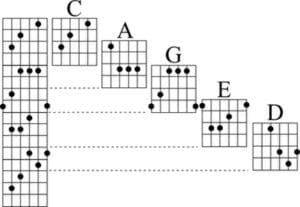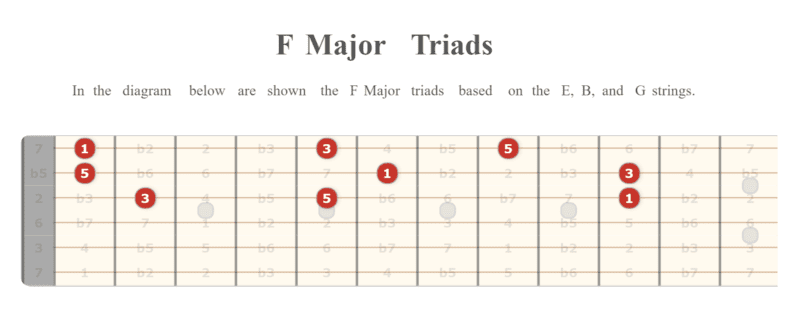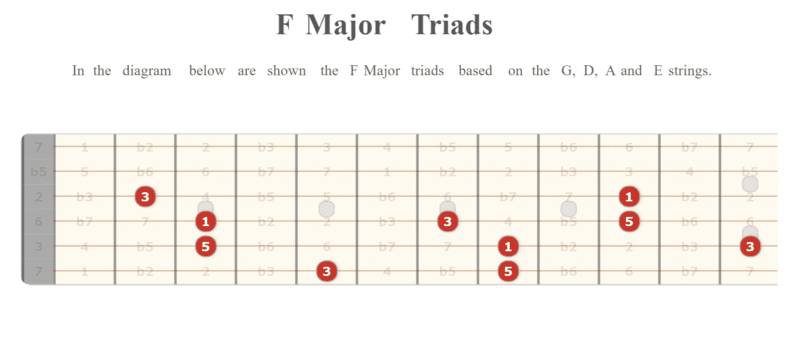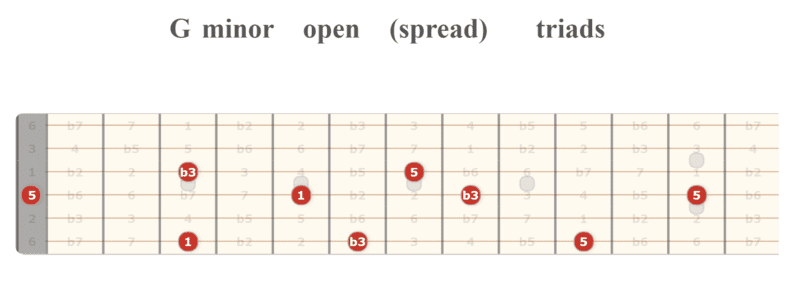Last update 5/2/2024
This tutorial will show you how to use guitar triads instead of the caged system to further your playing skills.
Table of contents
- Part one – Triads vs. caged system
- What are Spread Triads?
- What are the advantages of using spread Triads?
- Significant advantages of using spread triads
- This method offers many sonic possibilities when improvising.
- You can visualize intervals easily.
- Useful Diagrams
- How to practice Spread Triads on Guitar
- Run the shapes up and down the neck
- Play songs using spread triads.
- Triads in guitar soloing.
- In conclusion
- Resources
The CAGED system is an important technique that I recommend you learn. However, using the CAGED system and not grasping triads well also limits your playing potential.
This tutorial of 2 parts will cover advanced triads and spread triads’ voicings.
Part one – Triads vs. caged system
Our tutorial is for advanced beginners, intermediate, and advanced players. Of course, anyone can watch it, and if you do, I hope you get something from it. Also, this tutorial assumes you have a basic understanding of guitar theory.
In addition, I propose using guitar triads as an alternative to the CAGED system in this video.
Video one of two.
What is the CAGED system?
The Caged system is constructed from 5 different chord shapes. The shapes are derived from open chords, namely C, A, G, E, and D open chord shapes.


What Are Triads?
A triad is a chord that uses just three notes (tones). The notes are the third, fifth, and root.


Major and minor chords
For major chords, you need to refer to the open major chord shapes, while for the minor chords, refer to the open minor chord shapes of the C, A, G, E, and D chords. (see diagrams)
Why is the CAGED system limited?
The CAGED system explains the fretboard based on the shapes of chords, which are formed from triads and other extensions.
- C major open chord is built from C, E, and G.
- C (root) is repeated twice on the 3rd fret of the A and the 1st fret of the B.
- E (minor 3rd) repeated twice in the 2nd fret of the D and open high E.
- G (fifth) is only played once on the open G string
- The same logic applies to all other chords that make up the CAGED system.
Guitar players often have difficulty using them by visualizing the fretboard using chord shapes in sequence. In addition, using full chords makes it confusing to find intervals. Furthermore, it diverts attention from the all-important chord tones and scale shapes.
A much better approach is to remove the notes repeated in “full” chords and learn the shapes of the core triads (3 notes) across the neck.
Why is learning triads useful?
- Learning guitar triads gives you more flexibility playing lead and rhythm when compared to the CAGED for the following reasons.
- Learning three-note chord shapes vertically across the strings is more accessible than the CAGED system.
- Triads use just three notes, which makes learning triad shapes much more accessible.
- A G barre chord based on the 3rd fret of E strings can be played in the same fretboard area for at least five different shapes (spread Triads). Note: if you take out repeated notes.
- Organizing chords into smaller chunks makes it easier to use when soloing.
- When playing a guitar solo, especially if you are playing with a high-gain tone, a standard chord with four notes or more will often sound muddy.
- If you are hunting for a specific note to play, playing a fast run, or are just lost when a “weird” chord plays in the backing track – going with a triad is the way to go.
- Triads make learning the fretboard easier.
- Triads are a great way to get into chord inversion and extensions.
Inverted Chords
An inverted chord is a chord where the order in which the notes are played is altered. For example, If you play the C chord with 3rd in the bass (play the Low E along with the chord), you have played an interesting inverted chord. For this reason, If you wish to grasp inverted chords, you must know triads and intervals.


Useful Diagrams
The following images show F major triads, vertical across the neck, in sets of 3 and 4 strings. Start with the key of F major, then gradually use the same logic with other keys.






How about 7th chords and other extensions?
Extended chords are a core triad with an extension added.
Referencing the C major chords again, the C Major 7th chord is formed by the same Triad of C, E, G + the 7th intervals of the C major scale – the Bb. It’s important to realize the same logic applies to all other chord extensions. However, their names might sound complex and bring a chill to the spine of beginner guitarists.
“There’s a weird period of learning how to play guitar where your fingers are constantly messed up a handful.” – Jason Reeves
Learning the fretboard using triads might prove more helpful, even for this type of chord. Also, the extension is immediately highlighted as the extra note in the trio, making it easier to memorize the interval’s position and recall it when needed.
How do you practice guitar triads?
Practicing this system based on triads is pretty straightforward. It’s very similar to our approach to learning the CAGED system. However, the difference is that we focus more on the notes and intervals rather than the shapes.
I would encourage you to practice the following two exercises.
1-minute changes
In this exercise, you should aim for five different shapes of a Triad and go through them as fast as you can in 1 minute or less. Try to play the triad cleanly before switching to the next shape.
Soloing over one chord
Play a single chord, loop it, then play over it using the corresponding triad shapes across the neck. Furthermore, pay attention to the chord intervals you are playing. In addition, try singing the notes you are playing.
Use a metronome; actually, do so anytime you practice. Furthermore, as with almost any other practice for the guitar, start slow, increase the tempo, and aim to practice daily!
Final thoughts
Learning triad shapes across the neck is an excellent alternative to the CAGED system. Both approaches are similar and complement each other. It’s a beneficial method to learn your way around the fretboard. In addition, the system will help you to improvise all over the fretboard as well.
Remember, triad-based learning methods like the ones I have shown you will give you’re playing a big boost. The difference in learning is triads in the way I have suggested; it simply means intervals and chord tones rather than chord shapes.
An excellent dedicated practice routine and a good pinch of determination are needed to learn triads. Things might become more complex once you start putting chord inversions and spread treads on the mix, but stick with it.
Part 2 | Spread triads
In this video, I will show you how to use spread triads. In my previous video, I showed you how to use Triads as an alternative to the CAGED system.
Triads are the main building blocks of chords; they are easy to learn and apply in your rhythm and solo playing. In addition, triads will expand your playing skills; they offer more voicing choices, which increases your tonal decisions as a player and are particularly helpful in learning the guitar fretboard.
However, I will discuss spread triads and their use in this tutorial. Spread triads are triads where the emphasis is on interval and chord tones rather than shapes. However, the challenge is that more shapes must be learned, including complex chord variations and difficult hand stretches.
For this video, I will assume you are an advanced beginner or intermediate player just like the first.
What are Spread Triads?
Spread triads are triads that use notes in a different octave.
Take any triad in any inversion, for example, a G major triad formed from the notes G, B, and D. To from a spread triad, take any of the notes, for example, the D, and play that on a different string on a higher or lower octave. Congrats, you just played your first spread triad!
A spread triad can be formed from each inversion, meaning you can use either the root, first, or fifth on bass and change its octave. With three shapes for each inversion, each triad type has nine different voicings: Major, Minor, Sus2, Sus4, Diminished, and Augmented.
You can also play 7th chords or other chord extensions and take your blues chops to the next level by leaving out the 5th. However, starting from major and minor is good if you are new to the concept.
What are the advantages of using spread Triads?
The concept is straightforward, and many people use it without realizing it.
For example, Eric Johnson is one of the pioneers of soloing using spread triads. Many of his arpeggio fast runs for which he is known are just the same chord but played in different spread triad positions.
You play live and write songs. You practice that to bring the theory and the technique and create art with it. And you seek inspiration to make that art something that’s meaningful to you and which you can communicate to others.” Tom Morello
After watching the video or the chord diagrams, you may have realized you used some of the shapes demonstrated. However, you should be happy, as it’s always better to start playing and then analyze what you’re playing rather than vice versa.
Significant advantages of using spread triads
There are many alternative voice chords, and each voice gets a different character.
Chords can take on an entirely different character once you start playing around with different inversions and octaves. For example, they depend on how you play it. The same G major triad will sound completely different and more mellow, melodic, or unresolved.
This method offers many sonic possibilities when improvising.
You think spread triads are a tool to connect chord tones across different octaves. While solving, you could recall more than just the tone in the closed positions of scales. You could jump from octave to octave quickly and create some exciting melodies each time.
While playing with another guitar, you can play the same chords but on a spread triad shape. You can play guitar using spread triads as a piano player approaches playing.
You can visualize intervals easily.
To step up your playing, you should learn as much as possible about intervals and how to recognize or recall them. Spread Triads is an effective way to train your ears and hands to remember intervals.
Useful Diagrams






The diagrams below will be helpful when practicing spread triads and switching from closed to open voicings. Another key point is that everything is based on G major, and that’s where I recommend you start. If you want to start from another key, the next one I recommend is C major.
You can also start practicing minor spread triads by following the diagrams below. The principle is as follows: by lowering the 3rd a half step (one fret).






How to practice Spread Triads on Guitar
- Practicing spread triads follows the same concept as any other scale or chord system practice. Above all, you only need two ingredients, a metronome, and some patience, at least 10-15 minutes per day patience.
- Some good exercises to practice spread triads are the following 1-minute voicing changes.
- Set the alarm to ring each minute and pick only 3 to 4 shapes you will change within 1 minute. Remember to play each voicing as a chord and mute all the strings in between.
Run the shapes up and down the neck


Practice your G major spread shapes starting from the lower octave to the highest, back and forth to the click of a metronome. In addition, it might get tricky as you play a set of 3 notes, an odd number. You can spice it up by advancing to another key half-step up after each run.
Remember to play each triad note individually and avoid fingering notes using bars on your left hand.
Play songs using spread triads.
Take a simple chord progression of just 3 or 4 chords from any song you know. Now, spice things up and place a different spread triad of the chord and the music. Try changing triad shapes as you go along with the song, depending on how well you think you are doing with timing and localizing voicings.
Triads in guitar soloing.
Play a backing track and occasionally go to a spread triad chord shape and arpeggiate it when soloing. It might not sound very musical, but it will train you to find shapes quickly.
In conclusion
- Spread Triads are a great way to give more character to your chord shapes and help you learn the fretboard.
- They could be what separates you from other players and your ticket to becoming a better guitar player, able to play exciting lines and come up with cool parts over any chord progression.
- Take your time to learn them, as there are a lot of shapes you need to memorize and practice in the process.
If you have any questions, ask away in our friendly Facebook Group. See you there :)
Transparency disclosure: Some of the links in this post are affiliate links, meaning that I may earn a commission if you click on a link and make a purchase. This commission comes at no extra cost to you. We only recommend products and services that I believe are helpful and valuable, and we never let the potential for a commission influence our recommendations.
Amazon guitar books for triads
Resources
Guitar chord – Wikipedia. (2021). Retrieved 9 December 2021, from https://en.wikipedia.org/wiki/Guitar_chord



